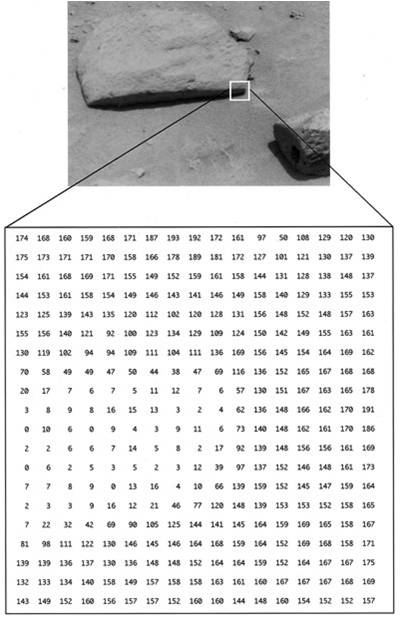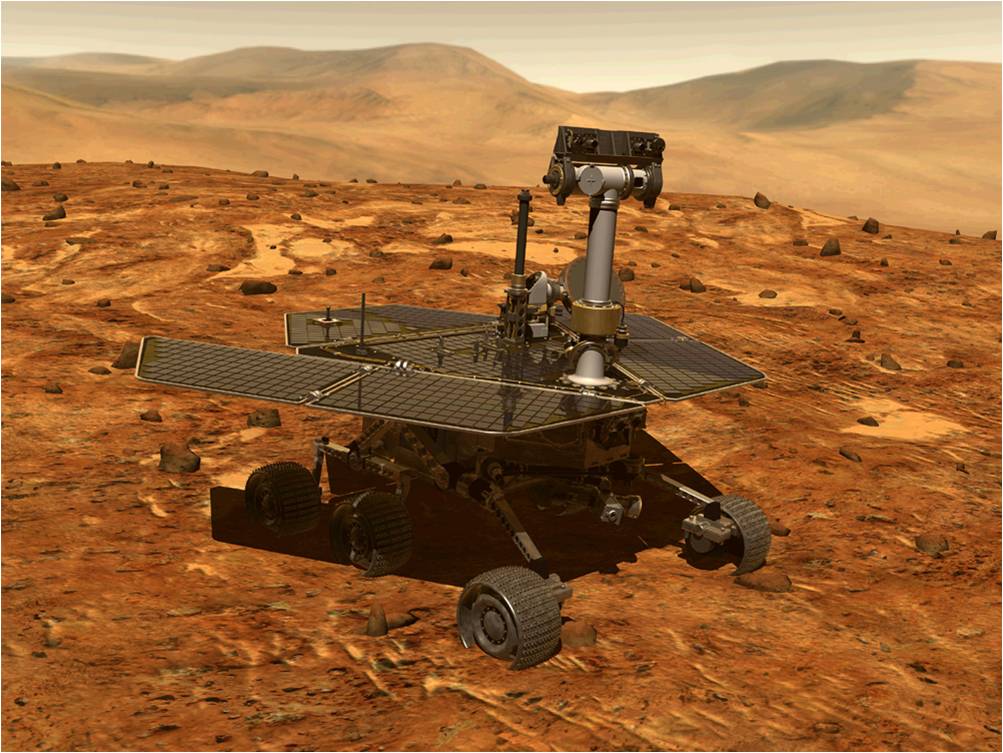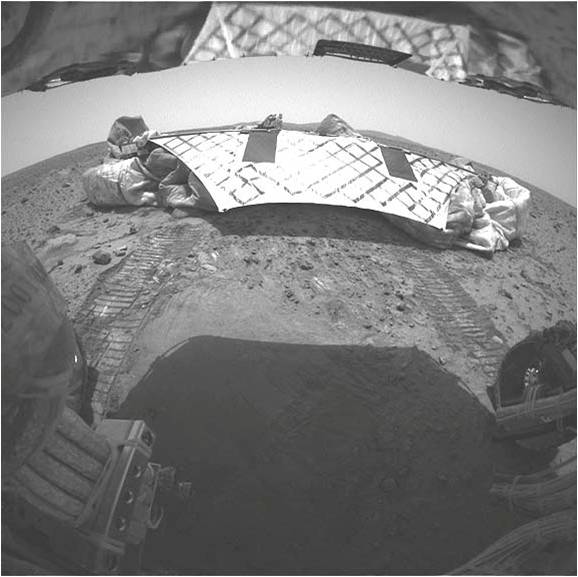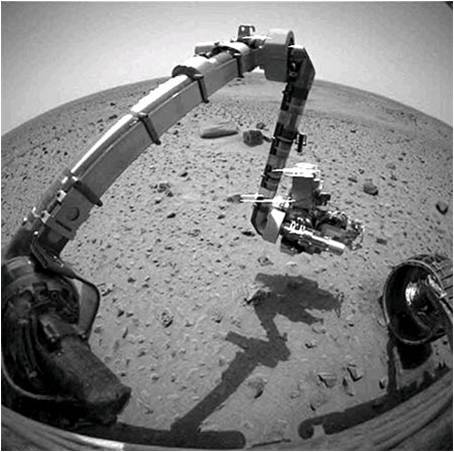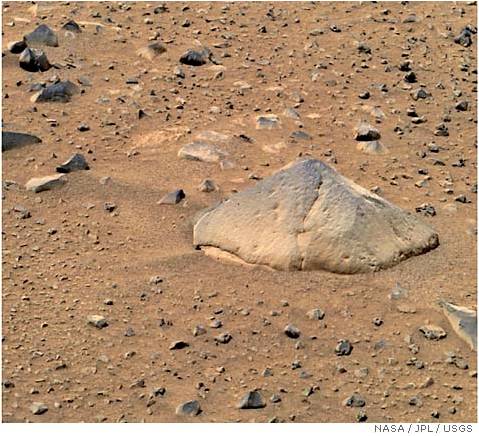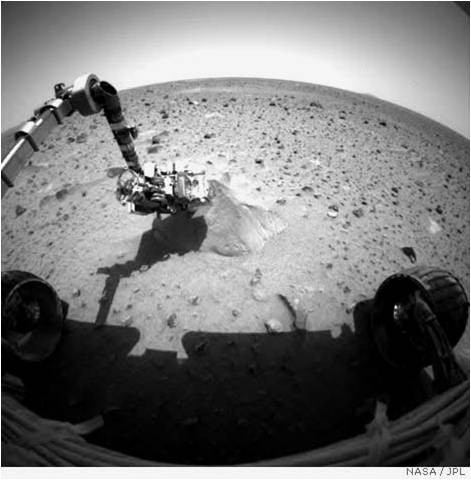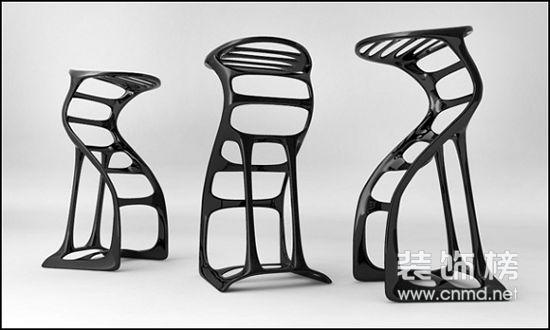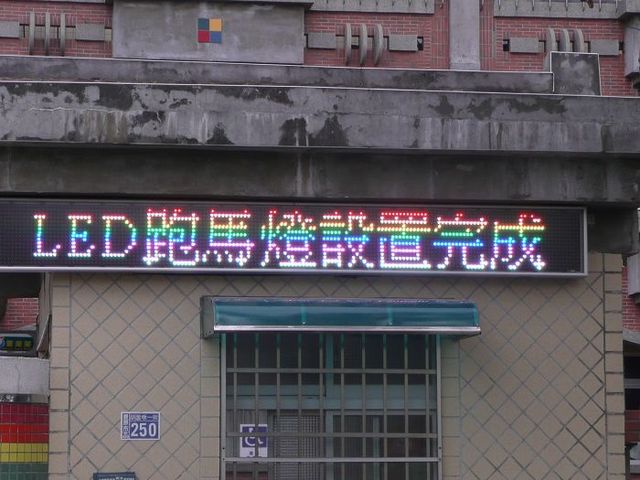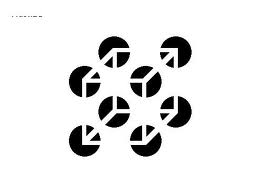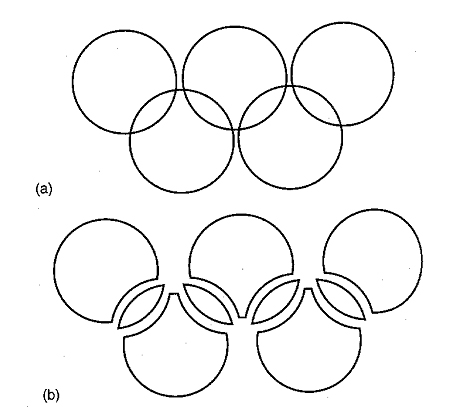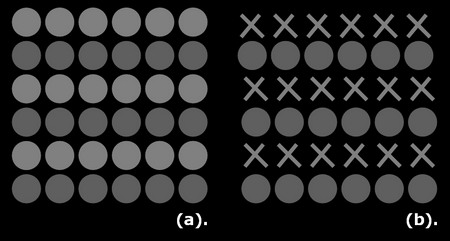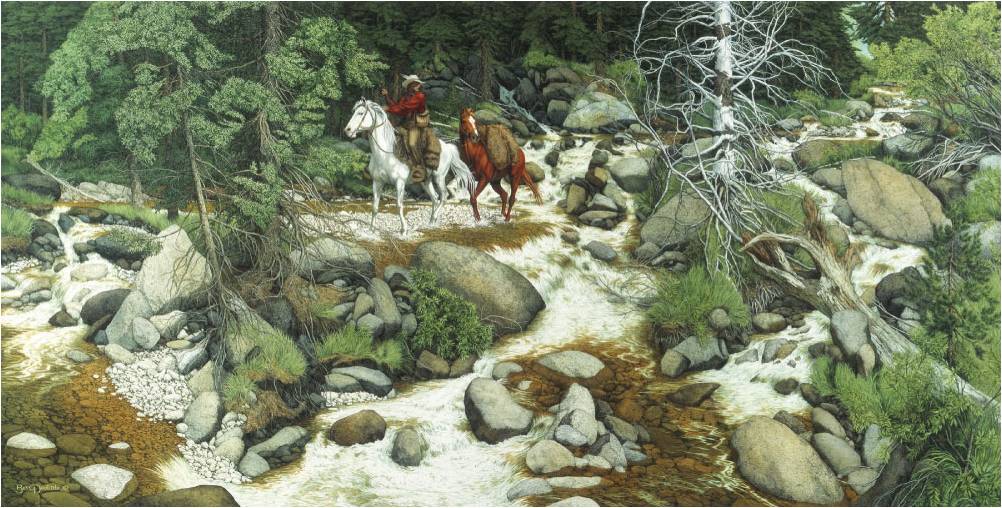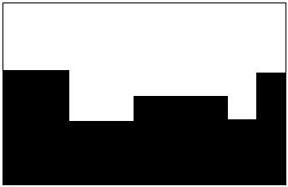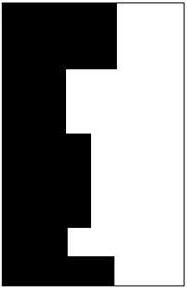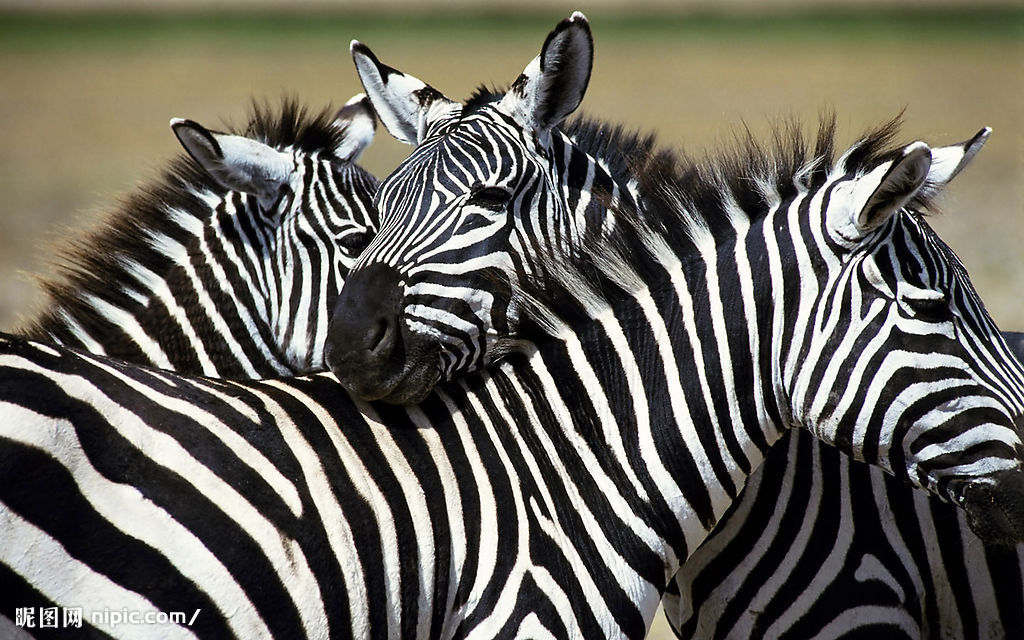第五講:Spatial Vision and Form Perception
出自KMU Wiki
(修訂版本間差異)
| 在2011年10月15日 (六) 15:27所做的修訂版本 (編輯) 98007021 (對話 | 貢獻) (→Voxels) ←上一個 |
當前修訂版本 (2012年10月15日 (一) 10:12) (編輯) (撤銷) Sakurai (對話 | 貢獻) (→Mary Potter(1976)) |
||
| (45個中途的修訂版本沒有顯示。) | |||
| 第1行: | 第1行: | ||
| =知覺心理學第五講= | =知覺心理學第五講= | ||
| - | ==日常所見= | + | ===日常所見=== |
| - | + | *Figure 5.1 | |
| - | + | ||
| - | + | ||
| - | + | ||
| - | + | ||
| - | + | ||
| - | + | ||
| - | == | + | ===機器視覺=== |
| - | + | *Figure 5.2 | |
| - | * | + | **車速最高 50Km/hr |
| - | ===== | + | **平均22Km/hr |
| + | |||
| + | ===Spirit in Mars=== | ||
| + | *spirit in Mars1 | ||
| + | **2004-1-4 Sashimi(生魚片) | ||
| + | |||
| + | [[Image:spirit1.jpg]] | ||
| + | |||
| + | *spirit in Mars2 | ||
| + | **spirit | ||
| + | [[Image:spirit2.jpg]] | ||
| + | |||
| + | |||
| + | *spirit in Mars3 | ||
| + | **登陸艇 | ||
| + | [[Image:spirit3.jpg]] | ||
| + | |||
| + | |||
| + | *spirit in Mars4 | ||
| + | **機械臂 | ||
| + | [[Image:spirit4.jpg]] | ||
| + | |||
| + | |||
| + | *spirit in Mars5 | ||
| + | **Adirondack | ||
| + | **形狀類似美國阿爾崗金族印第安人的帳篷故得名 | ||
| + | [[Image:spirit5.jpg]] | ||
| + | |||
| + | |||
| + | *spirit in Mars6 | ||
| + | **get a X-ray | ||
| + | [[Image:spirit6.jpg]] | ||
| + | |||
| + | ==Inverse projection problem (p.101)== | ||
| + | *又稱 Inverse Optics | ||
| + | *一個在視網膜上的特定影像,可能是由不同的物件造成的。 | ||
| + | *Figure 5.3 | ||
| + | |||
| + | |||
| + | *Figure 5.4 | ||
| *An environmental sculpture by Thomas Macaulay | *An environmental sculpture by Thomas Macaulay | ||
| - | * | + | **從二樓陽台看 |
| - | + | **從一樓看 | |
| - | =====Figure 5.5===== | ||
| - | *找一找鉛筆和眼鏡 | ||
| - | == | + | ==Objects Can Be Hidden or Blurred(p.102)== |
| - | + | ||
| - | + | *Figure 5.5 | |
| - | * | + | **找一找鉛筆和眼鏡 |
| - | ===== | + | *Figure 5.6 |
| - | *哪些照片是同一個人? | + | **這些人是誰? |
| + | |||
| + | |||
| + | *即使物品的某些部分被遮住或被弄得模糊,人們仍可以知道那是什麼。 | ||
| + | |||
| + | ==Objects Look Different From Different Viewpoint(p.102)== | ||
| + | |||
| + | ====Viewpoint invariance==== | ||
| + | 可以從不同的角度辨別物件的能力。 | ||
| + | |||
| + | *Figure 5.7 | ||
| + | **從不同角度看 | ||
| + | [[Image:Figure 5.7.jpg]] | ||
| + | |||
| + | |||
| + | *Figure 5.8 | ||
| + | **哪些照片是同一個人? | ||
| + | **電腦臉孔辨識系統會認為a和b較相似 | ||
| ==The Gestalt Approach to Object Perception P.104== | ==The Gestalt Approach to Object Perception P.104== | ||
| 第33行: | 第80行: | ||
| ====完形心理學==== | ====完形心理學==== | ||
| - | *Figure 5. | + | *Figure 5.9 |
| + | **根據這些點(dot)累積創造出我們對臉的知覺的嗎? | ||
| - | ====似動現象(Apparent Movement)==== | + | ====似動現象(Apparent Movement)p.104==== |
| *Figure 5.10 | *Figure 5.10 | ||
| + | **(a)左邊先閃,50毫秒後右邊再閃,看起來像是從左移動到右 | ||
| + | **(b)跑馬燈即是利用似動現象 | ||
| + | [[Image:Figure 5.10.jpg]] | ||
| ====錯覺輪廓(Illusory Contour)==== | ====錯覺輪廓(Illusory Contour)==== | ||
| *Figure 5.11 | *Figure 5.11 | ||
| + | (a)[[Image:Figure 5.11a.jpg]] | ||
| + | (b)[[Image:Figure 5.11b.png]] | ||
| + | |||
| + | ==The Gestalt Laws of Perceptual Organization (p.105)== | ||
| + | |||
| + | ====Law of pragnanz==== | ||
| + | *也稱law good figure 或 law of simplicity | ||
| + | *我們會用最簡單的方式來解讀所接受到的視覺刺激 | ||
| - | + | *Figure 5.13 | |
| + | **我們通常會將(a)視為五個圈圈,而非(b)那個樣子 | ||
| + | [[Image:Figure 5.13.jpg]] | ||
| ====相似性 law of similarity==== | ====相似性 law of similarity==== | ||
| - | * | + | *Figure 5.14 |
| - | + | [[Image:Figure 5.14.jpg]] | |
| - | + | ||
| - | *共同區域(Common Region,圖5.18b)、 | ||
| - | 連結律(Uniform Connectedness,圖5.18c)、 | ||
| - | 以及同步發生(Synchrony,圖5.18d) | ||
| - | * | + | *Figure 5.15 |
| + | **身體、肢體、球桿、視線方向均相似 | ||
| + | **其他例子 | ||
| + | [[Image:Figure 5.15.jpg]] | ||
| + | ====Good continuation==== | ||
| + | *Figure 5.16 | ||
| + | |||
| + | *Figure 5.17 | ||
| + | **好的連續效果被視為交織鏈 | ||
| + | |||
| + | ====共同區域Common Region==== | ||
| + | *Figure5.18b | ||
| + | |||
| + | ====連結律Uniform Connectedness==== | ||
| + | *Figure 5.18c | ||
| + | |||
| + | ====同步發生Synchrony==== | ||
| + | *Figure 5.18d | ||
| + | |||
| + | |||
| + | ====Common fate==== | ||
| + | *Figure 5.19 | ||
| + | |||
| + | |||
| + | ====Meaningfulness or Familiarity==== | ||
| + | *Figure 5.20 | ||
| *12張臉孔在內? | *12張臉孔在內? | ||
| + | |||
| [[Image:Forest faces.jpg]] | [[Image:Forest faces.jpg]] | ||
| - | *你看到什麼? | + | *具有意義或對觀察者較熟悉的刺激,會被視為一體,所以初看為一幅畫 |
| + | |||
| + | ==Perceptual Segregation: How Objects Are Separated From the Background== | ||
| + | |||
| + | *Figure 5.21 | ||
| + | **你看到什麼? | ||
| + | [[Image:Figure 5.21.png]] | ||
| + | |||
| + | |||
| + | *Figure 5.22 | ||
| **知覺到的其中一個物體,另一個就成為背景 | **知覺到的其中一個物體,另一個就成為背景 | ||
| - | * | + | *Figure 5.23 |
| - | (a)實驗呈現方式 | + | **(a)實驗呈現方式 |
| - | (b) | + | **(b)當深色方塊被看成背景,則小黑點落在小方塊邊界上 |
| - | + | **(c)當被看成中間有孔的深色方塊, | |
| - | (c)當被看成中間有孔的深色方塊, | + | |
| 則小黑點落在黑色方塊邊界上 | 則小黑點落在黑色方塊邊界上 | ||
| - | + | ====Figure ground separation 圖形背景分離==== | |
| - | separation | + | *Figure 5.24 |
| - | + | **人們普遍認為東西應該是放地上的,因此在(a)中有約75%受試者認為左圖的紅色區域為物體 | |
| + | **而當圖片為左右放置時(a右),選擇紅色或綠色的受試者各占一半 | ||
| + | |||
| + | (a)[[Image:Figure 5.24a.jpg]] | ||
| + | (b)[[Image:Figure 5.24b.jpg]] | ||
| + | |||
| + | |||
| + | *Figure 5.25 | ||
| + | **(a)對稱的較常被看成是物體 | ||
| + | **(b)較小的區域較常被看成是物體 | ||
| + | **(c)垂直和平行的較常被看成是物體 | ||
| + | **(d)黑的部分較常被看成是物體 | ||
| + | |||
| + | ==Gestalt law as Heuristics== | ||
| - | ====Gestalt law as Heuristics==== | ||
| ====Recognition by component==== | ====Recognition by component==== | ||
| 第80行: | 第183行: | ||
| *上面的三條線 | *上面的三條線 | ||
| *上面的兩條線 | *上面的兩條線 | ||
| - | 都是非偶發特性(non-accidental | + | 都是非偶發特性(non-accidental properties) |
| - | + | ||
| *Biederman的實驗 | *Biederman的實驗 | ||
| 第91行: | 第193行: | ||
| *3個geons的飛機 | *3個geons的飛機 | ||
| - | + | ==場景知覺(Gist of the Scene)p.114== | |
| - | + | ====Mary Potter(1976)==== | |
| - | + | *快速呈現16張複雜場景圖片,每張只呈現250毫秒。 | |
| - | * | + | *在一連串呈現之前看到目標圖片或只是提示語(如:小女生在拍手) |
| - | + | *結果受試者都可以看得到 | |
| - | * | + | *Figure 5.34 |
| - | + | ====Li Fei-Fei (2007)p.114==== | |
| - | + | *利用masking | |
| - | + | *每張圖片呈現27到500毫秒,每張圖片呈現完之後會呈現一個mask來精確控制刺激呈現時間 | |
| - | + | *結果67ms 即可辨識 | |
| - | * | + | *Figure5.35 |
| - | *Masking | ||
| - | **masking procedure | ||
| - | ** | + | ====Masking==== |
| + | *masking procedure | ||
| + | *抵消persistence of vision | ||
| + | |||
| ====Global Image Feature==== | ====Global Image Feature==== | ||
| 第116行: | 第219行: | ||
| **Degree of expansion | **Degree of expansion | ||
| **Color | **Color | ||
| - | + | **Figure 5.36 | |
| + | |||
| + | |||
| + | ==Information for Perceiving (p.115)== | ||
| ====light-from-above heuristic==== | ====light-from-above heuristic==== | ||
| - | * | + | *Figure 5.37 |
| - | * | + | **自然而然認為光是從上方來(經驗所學) |
| - | + | *Figure 5.38 | |
| - | *Figure 5. | + | **實例 |
| - | + | ||
| - | + | ||
| - | + | ||
| - | + | ||
| - | + | ||
| - | + | ||
| - | + | ||
| - | + | ||
| - | + | ||
| - | ** | + | |
| - | + | ====Semantic Regularity(p.117)==== | |
| - | * | + | *Figure 5.39 |
| - | ** | + | **Hollingworth (2005) |
| - | ** | + | **前圖為例,條件為二 |
| - | ** | + | ***目標出現 |
| + | ***目標不出現 | ||
| + | **作業 | ||
| + | ***目標出現在何處 | ||
| + | ***目標該出現在何處(在無目標條件下) | ||
| + | **結果 | ||
| + | ***小圓:目標出現時 | ||
| + | ***大圓:目標不出現時 | ||
| - | *Figure 5. | + | *Figure 5.40 |
| - | * | + | **Palmer (1975) |
| - | * | + | ***先呈現給受試者流理台的圖片(圖5.40左) |
| + | ***然後再快速閃現另一組圖片(圖5.40右) | ||
| + | ***當後面出現的這張圖片為麵包的時候,受試者的正確率較高。 | ||
| + | *Figure 5.41 | ||
| + | **multiple personalities of blob | ||
| + | **Oliva & Torralba (2007) | ||
| == The Role of Inference in Perception== | == The Role of Inference in Perception== | ||
| 第161行: | 第269行: | ||
| *Bayesian inference | *Bayesian inference | ||
| - | ==Neurons That Responds to Perceptual Grouping and Figure-Ground(p.120)== | + | ==Neurons That Responds to Perceptual Grouping and Figure-Ground <br><br>(p.120)== |
| ====Neurons of grouping==== | ====Neurons of grouping==== | ||
| 第177行: | 第285行: | ||
| **如果線條符合V1細胞的接受區形式且在「圖形」中:反應(a) | **如果線條符合V1細胞的接受區形式且在「圖形」中:反應(a) | ||
| **如果線條符合V1細胞的接受區形式但不在「圖形」中:不反應(b) | **如果線條符合V1細胞的接受區形式但不在「圖形」中:不反應(b) | ||
| - | |||
| ==How Does the Brain Respond to Objects?== | ==How Does the Brain Respond to Objects?== | ||
| 第216行: | 第323行: | ||
| *Voxels(volumetric pixel) | *Voxels(volumetric pixel) | ||
| *fMRI Voxels → 2~3mm立方體 | *fMRI Voxels → 2~3mm立方體 | ||
| + | |||
| ====Kamitani and Tong(2005)==== | ====Kamitani and Tong(2005)==== | ||
| 第224行: | 第332行: | ||
| **發現腦部反應可以預測觀察者的注意力是在哪個傾斜刺激上 | **發現腦部反應可以預測觀察者的注意力是在哪個傾斜刺激上 | ||
| - | ====Kay等人(2008)實驗==== | + | |
| + | ====Kay等人(2008)實驗 p.125==== | ||
| *呈現1,750黑白照片 | *呈現1,750黑白照片 | ||
| *測量V1的500個voxels | *測量V1的500個voxels | ||
| 第230行: | 第339行: | ||
| *由voxels的活動猜測觀察者所見 | *由voxels的活動猜測觀察者所見 | ||
| *正確率72~92% | *正確率72~92% | ||
| - | ** | + | **figure 5.52 |
| - | ** | + | |
| + | *Kay等人(2008)實驗結果 | ||
| + | **Figure 5.53 | ||
| + | |||
| + | |||
| + | ==Think About It== | ||
| + | *Figure 5.54 | ||
| + | *斑馬的紋是有何用處? | ||
| + | |||
| + | [[Image:Figure 5.54.jpg]] | ||
| + | |||
| + | |||
| + | [[知覺心理學]] | ||
當前修訂版本
[編輯] 知覺心理學第五講
[編輯] 日常所見
- Figure 5.1
[編輯] 機器視覺
- Figure 5.2
- 車速最高 50Km/hr
- 平均22Km/hr
[編輯] Spirit in Mars
- spirit in Mars1
- 2004-1-4 Sashimi(生魚片)
- spirit in Mars2
- spirit
- spirit in Mars3
- 登陸艇
- spirit in Mars4
- 機械臂
- spirit in Mars5
- Adirondack
- 形狀類似美國阿爾崗金族印第安人的帳篷故得名
- spirit in Mars6
- get a X-ray
[編輯] Inverse projection problem (p.101)
- 又稱 Inverse Optics
- 一個在視網膜上的特定影像,可能是由不同的物件造成的。
- Figure 5.3
- Figure 5.4
- An environmental sculpture by Thomas Macaulay
- 從二樓陽台看
- 從一樓看
[編輯] Objects Can Be Hidden or Blurred(p.102)
- Figure 5.5
- 找一找鉛筆和眼鏡
- Figure 5.6
- 這些人是誰?
- 即使物品的某些部分被遮住或被弄得模糊,人們仍可以知道那是什麼。
[編輯] Objects Look Different From Different Viewpoint(p.102)
[編輯] Viewpoint invariance
可以從不同的角度辨別物件的能力。
- Figure 5.7
- 從不同角度看
- Figure 5.8
- 哪些照片是同一個人?
- 電腦臉孔辨識系統會認為a和b較相似
[編輯] The Gestalt Approach to Object Perception P.104
[編輯] 完形心理學
- Figure 5.9
- 根據這些點(dot)累積創造出我們對臉的知覺的嗎?
[編輯] 似動現象(Apparent Movement)p.104
- Figure 5.10
- (a)左邊先閃,50毫秒後右邊再閃,看起來像是從左移動到右
- (b)跑馬燈即是利用似動現象
[編輯] 錯覺輪廓(Illusory Contour)
- Figure 5.11
[編輯] The Gestalt Laws of Perceptual Organization (p.105)
[編輯] Law of pragnanz
- 也稱law good figure 或 law of simplicity
- 我們會用最簡單的方式來解讀所接受到的視覺刺激
- Figure 5.13
- 我們通常會將(a)視為五個圈圈,而非(b)那個樣子
[編輯] 相似性 law of similarity
- Figure 5.14
- Figure 5.15
- 身體、肢體、球桿、視線方向均相似
- 其他例子
[編輯] Good continuation
- Figure 5.16
- Figure 5.17
- 好的連續效果被視為交織鏈
[編輯] 共同區域Common Region
- Figure5.18b
[編輯] 連結律Uniform Connectedness
- Figure 5.18c
[編輯] 同步發生Synchrony
- Figure 5.18d
[編輯] Common fate
- Figure 5.19
[編輯] Meaningfulness or Familiarity
- Figure 5.20
- 12張臉孔在內?
- 具有意義或對觀察者較熟悉的刺激,會被視為一體,所以初看為一幅畫
[編輯] Perceptual Segregation: How Objects Are Separated From the Background
- Figure 5.21
- 你看到什麼?
- Figure 5.22
- 知覺到的其中一個物體,另一個就成為背景
- Figure 5.23
- (a)實驗呈現方式
- (b)當深色方塊被看成背景,則小黑點落在小方塊邊界上
- (c)當被看成中間有孔的深色方塊,
則小黑點落在黑色方塊邊界上
[編輯] Figure ground separation 圖形背景分離
- Figure 5.24
- 人們普遍認為東西應該是放地上的,因此在(a)中有約75%受試者認為左圖的紅色區域為物體
- 而當圖片為左右放置時(a右),選擇紅色或綠色的受試者各占一半
- Figure 5.25
- (a)對稱的較常被看成是物體
- (b)較小的區域較常被看成是物體
- (c)垂直和平行的較常被看成是物體
- (d)黑的部分較常被看成是物體
[編輯] Gestalt law as Heuristics
[編輯] Recognition by component
[編輯] Non-accidental properties
- 上面的三條線
- 上面的兩條線
都是非偶發特性(non-accidental properties)
- Biederman的實驗
[編輯] Nonaccidental properties
- 6個geons的飛機
- 3個geons的飛機
[編輯] 場景知覺(Gist of the Scene)p.114
[編輯] Mary Potter(1976)
- 快速呈現16張複雜場景圖片,每張只呈現250毫秒。
- 在一連串呈現之前看到目標圖片或只是提示語(如:小女生在拍手)
- 結果受試者都可以看得到
- Figure 5.34
[編輯] Li Fei-Fei (2007)p.114
- 利用masking
- 每張圖片呈現27到500毫秒,每張圖片呈現完之後會呈現一個mask來精確控制刺激呈現時間
- 結果67ms 即可辨識
- Figure5.35
[編輯] Masking
- masking procedure
- 抵消persistence of vision
[編輯] Global Image Feature
- Oliva and Torralba (2001, 2006)
- Degree of naturalness
- Degree of openness
- Degree of roughness
- Degree of expansion
- Color
- Figure 5.36
[編輯] Information for Perceiving (p.115)
[編輯] light-from-above heuristic
- Figure 5.37
- 自然而然認為光是從上方來(經驗所學)
- Figure 5.38
- 實例
[編輯] Semantic Regularity(p.117)
- Figure 5.39
- Hollingworth (2005)
- 前圖為例,條件為二
- 目標出現
- 目標不出現
- 作業
- 目標出現在何處
- 目標該出現在何處(在無目標條件下)
- 結果
- 小圓:目標出現時
- 大圓:目標不出現時
- Figure 5.40
- Palmer (1975)
- 先呈現給受試者流理台的圖片(圖5.40左)
- 然後再快速閃現另一組圖片(圖5.40右)
- 當後面出現的這張圖片為麵包的時候,受試者的正確率較高。
- Palmer (1975)
- Figure 5.41
- multiple personalities of blob
- Oliva & Torralba (2007)
[編輯] The Role of Inference in Perception
[編輯] Theory of unconscious inference (P.118)
當我們面對不清楚的刺激時,視覺系統會根據其他各種條件,比如過去經驗,去推測當下的刺激為何。這樣的知覺推理歷程稱之為theory of unconscious inference
- Figure 5.42
- likelihood principle
- Bayesian inference
[編輯] Neurons That Responds to Perceptual Grouping and Figure-Ground
(p.120)
[編輯] Neurons of grouping
- Figure 5.43
- 原來對垂直線段有最佳反應的神經細胞(5.43a)
- 若置於其它隨機角度的線段中,反應會受到抑制(5.43b)
- 但若置於具有共線關係的線段中,便又使得反應增強(5.43c)
[編輯] Contextual modulation
- Figure 5.44
- Lamme (1995)
- 如果線條符合V1細胞的接受區形式且在「圖形」中:反應(a)
- 如果線條符合V1細胞的接受區形式但不在「圖形」中:不反應(b)
[編輯] How Does the Brain Respond to Objects?
[編輯] Sensory coding(p.121)
- Figure5.45
- 在臉部知覺的部分,以下幾個區域會有怎樣的反應?
[編輯] Connecting Neural Activity and Perception
[編輯] Grill-Spector (2004) p.122
- Grill-Spector(2004)之實驗
- Figure 5.46
- Grill-Spector(2004)之實驗結果
- Figure 5.47
- fMRI資料顯示,FFA不只對是否看到臉有不同反應,也會因為受試者的反應正確與否而有不同的反應
[編輯] Sheinberg and Logothesis (1997) p.122
- Figure 5.48
- binocular rivalry
- IT上的細胞會根據猴子的主觀知覺是看到類似太陽的刺激還是蝴蝶而有不同的反應
[編輯] Tong等人(1998)實驗 p.123
- Figure 5.49
- 當觀看者,經驗到非臉,則 PPA>FFA
- 經驗到臉,則 FFA>PPA
[編輯] 延伸:
Models of Brain Activity That Can Predict What a Person Is Looking At
[編輯] Voxels
- Voxels(volumetric pixel)
- fMRI Voxels → 2~3mm立方體
[編輯] Kamitani and Tong(2005)
- Figure 5.50
- 可以由Voxels預測觀察者所見的傾斜方向
- Figure 5.51
- 發現腦部反應可以預測觀察者的注意力是在哪個傾斜刺激上
[編輯] Kay等人(2008)實驗 p.125
- 呈現1,750黑白照片
- 測量V1的500個voxels
- 整理voxels之活動之後經過數學處理
- 由voxels的活動猜測觀察者所見
- 正確率72~92%
- figure 5.52
- Kay等人(2008)實驗結果
- Figure 5.53
[編輯] Think About It
- Figure 5.54
- 斑馬的紋是有何用處?
